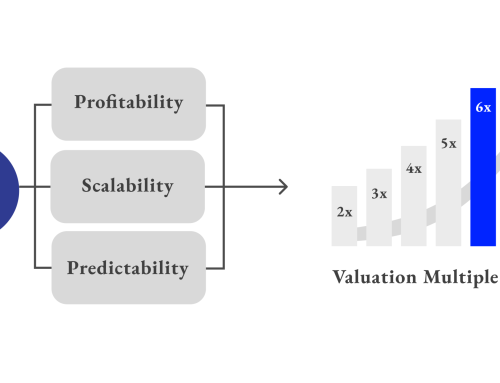
Most business owners are clear on their revenue and profit—but not on what their business is actually worth. The difference between those two realities is often vast. Hidden beneath strong sales and healthy margins lies an uncomfortable truth: your company’s enterprise value may be far lower than you think.
That difference is what Arcova Advisors calls the Value Gap—the space between your company’s current market value and what it could be worth (if it were built to run without you).
Closing that gap is one of the most effective, least-understood paths to wealth creation.
The Value Gap Explained
Every private company has two numbers that define its potential:
- Current Value: What your business would sell for today.
- Optimized Value: What it could command if it were fully systemized, scalable, and owner-independent.
The gap between them is unrealized wealth. For many founders, it represents 30% to 70% of their business’s potential sale price. It’s the silent tax on every hour you work, the opportunity cost of a company that’s not yet built for transferability.
Why Most Businesses Fall Into the Gap
The Value Gap often forms over years of reactive decision-making. Businesses grow around their owner’s habits instead of scalable systems. Success hides structural weaknesses—until a buyer looks under the hood.
Common culprits include:
- Owner dependency: Key knowledge lives only in the founder’s head.
- Customer concentration: Too much revenue tied to a few major clients.
- Lack of documented systems: Processes aren’t standardized or measurable.
- Weak financial visibility: Reports are late, inconsistent, or incomplete.
- Limited scalability: Growth depends on adding people, not improving processes.
Each of these factors erodes value in two ways: by reducing profitability today and by lowering the multiple a buyer will pay tomorrow.
Why Closing the Value Gap Pays Now—Not Just at Exit
The beauty of value-focused management is that it pays twice.
- Immediate ROI: Systemization reduces waste, improves margins, and increases cash flow.
- Long-Term ROI: The same improvements make your business more transferable, driving a higher valuation multiple.
A business designed to be sellable becomes easier—and more enjoyable—to own.
Step 1: Quantify the Gap
You can’t manage what you don’t measure. The process begins with a professional valuation that assesses your business from a buyer’s perspective. This baseline identifies where your current value sits relative to your potential future value.
Arcova Advisors uses proprietary valuation modeling to calculate both: your today number and your tomorrow number. The difference between the two becomes your opportunity target.
Step 2: Identify the Drivers of Enterprise Value
Buyers look for three primary qualities in any acquisition:
- Profitability: Demonstrated financial performance with predictable margins.
- Scalability: Systems that allow growth without chaos.
- Transferability: The business runs smoothly without its founder.
Every operational, financial, or marketing improvement should map back to one of these three. When aligned correctly, they create the structural integrity buyers reward.
Step 3: Build a Value Creation Roadmap
Once the Value Gap is quantified, the next step is to close it with precision.
Arcova’s Value Creation Roadmap defines a step-by-step plan to increase your company’s multiple and profitability simultaneously. It typically includes:
- Operational Discipline: Documenting SOPs and key workflows.
- AI Integration: Automating manual tasks to improve EBITDA.
- Leadership Installation: Bringing in fractional executives to manage by data, not instinct.
- Performance Tracking: Establishing KPIs that prove improvement quarter by quarter.
The roadmap becomes both a growth plan and an exit strategy, turning daily progress into tangible enterprise value.
Step 4: Execute and Measure
Execution without measurement is just activity. Each initiative in your roadmap should have a defined ROI target—cash flow improvement, efficiency gain, or valuation lift.
Arcova clients use quarterly “value reviews” to track these metrics. When improvements are tied directly to enterprise value, decision-making becomes disciplined. Instead of asking “Can we afford this?” you start asking “Will this increase our valuation multiple?”
Step 5: Repeat—The Compounding Effect
Closing the Value Gap isn’t a one-time event; it’s a cycle. Every improvement compounds. A small EBITDA lift or process improvement today multiplies through your valuation over time.
For example, increasing annual profit by $200,000 at a 5× multiple adds $1 million in enterprise value. The compounding effect is real and measurable.
Key Takeaways
- The Value Gap represents hidden wealth that can be unlocked through strategic improvements.
- Closing the gap increases profit today and valuation tomorrow.
- Every decision should tie back to profitability, scalability, or transferability.
Businesses built for sale are more efficient and resilient—even if you never sell.
Your company may already be successful—but is it valuable? Understanding and closing your Value Gap is the difference between building income and building wealth.




